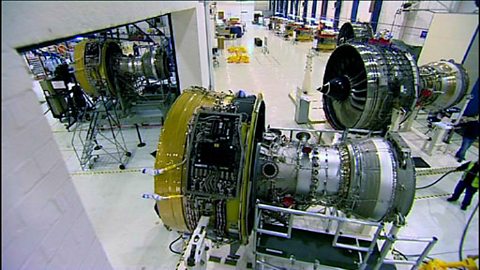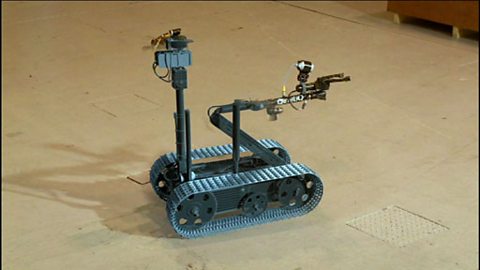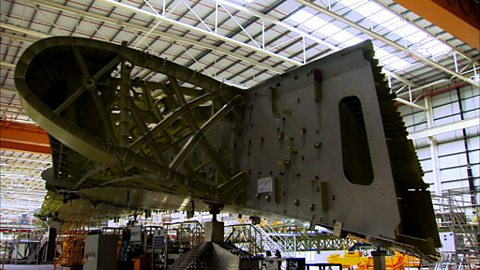MAN IN BLACK SUIT JACKET:It must be right first time. You can't service it, you can't bring it back, you can't complain to the manufacturer that it doesn't work.
MAN IN WHITE LAP COAT:Failure in space is not an option.
MAN IN WHITE SHIRT AND SUIT:Space is incredibly special. What we do is quite exceptional here.
NARRATOR:'Temperatures in space can fluctuate between a very cold -200 degrees Centigrade to a blistering 150 degrees Centigrade. And one of the biggest challenges in satellite design is keeping the temperature inside it fairly constant. This is very important, because it's full of delicate and complex electronics
NARRATOR:'that would stop working if they got either too hot or too cold. So how do designers and engineers tackle this, and solve the problem? The secret lies in the use of special materials.'
KATY SMITH:My name's Katy Smith, I'm a thermal architect here,
KATY SMITH:and I've been working here for just about six years. My job is thermal design, the build, the test of the spacecraft. Deep space environment's incredibly hostile. It's incredibly cold, -270C, whereas the sun-pointing surface could be in the region of 150, if not more. An including on that, you're in a vacuum.
KATY SMITH:So there's no convective environment, you can't reject heat, like you would, for example, your cup of tea, when you blow on it, removes the heat, doesn't exist.
NARRATOR:'The satellite needs to be able to operate within these massive temperature differences.'
KATY SMITH:If we sent spacecrafts up into space with no insulation it wouldn't work. You'd have one side with severe damage to the structure because of the Sun's influence, you'd have possible panels dropping off, so the distortions caused by the very temperature differences would buckle the structure and destroy it.'
NARRATOR:'The heat isn't just a problem on the outside of the satellite, because these extremes of temperature could be disastrous for all the on-board electronics inside. They can only operate between a cold -10 degrees to a warm 40 degrees. So to keep the internal temperature within this range, the satellite is wrapped in material called Kapton
NARRATOR:'which is also found in computers and solar panels.'
KATY SMITH:Kapton is the high-temperature layer. It's very robust, you can use it in an environment from -250 degrees C up to a continuous operating temperature of about 290 degrees C. I think the best way of describing it to a home product would be a Quality Street wrapper. It's difficult to tear, incredibly light,
KATY SMITH:so for a space environment, it's hugely applicable.
NARRATOR:'But Kapton can't protect the satellite on its own.'
KATY SMITH:What you're actually seeing here is a very thin deposition of aluminium. So here when you can see the gold outer layer, it's not actually gold, what you're seeing is the vacuum-deposit aluminium behind the Kapton, like that, giving it an amber or gold effect.
NARRATOR:'The aluminium-backed Kapton forms a blanket, insulating the satellite, and preventing heat being lost to deep space. While at the same time, helping to stop the Sun overheating the electronics inside.
KATY SMITH:I know it seems kind of counterintuitive because you've got large amounts of energy coming in from the Sun, but to balance it out and find a happy medium you have to block some of the sun, dump some of the heat, and supply some heat internally. It's a really complicated juggling act.
NARRATOR:'The Kapton blanket is the first line of defence at keeping the satellite at a reasonably constant temperature. But the electronics inside also create their own heat, and this also needs to be dissipated. To do this, some very clever engineering is incorporated into panels that form part of the satellite's structure.'
NARRATOR:These panels are covered with a complex matrix of pipes, and these pipes act as massive radiators, dumping heat generated by the electronics, and keeping the internal temperature constant.'
KATY SMITH:'A heat pipe is a very, very effective method of moving heat from one local region to another. There's no working parts, no electricity required, so power-wise it's good.'
NARRATOR:'But unlike household radiators, these pipes contain ammonia, because it boils and vaporises at just the right temperature, 33 degrees Centigrade.'
KATY SMITH:'So what happens is' at one end in the hot, high-power dissipation region, what will be a liquid at that stage, evaporates. The vapour then travels up the tube up the centre of the tube, to the cold region. And at his region it condenses. It dumps the heat, and then travels back down
KATY SMITH:to start the whole cycle again in the form of a liquid.
NARRATOR:'Satellites allow us to send television pictures and communicate over vast distances, using all the modern technology the world has to offer. But they wouldn't be able to operate if it wasn't for clever engineering and the use of special materials.'
Video summary
Satellites have to withstand incredibly hostile conditions in space.
Temperatures can fluctuate between 150 degrees Celsius and minus 200 degrees Celsius, so it’s imperative that a satellite’s on-board electronics are protected from these extreme conditions.
Katy Smith, a Thermal Architect, explains some of the clever innovations engineers use to keep the interior at a constant temperature.
Teacher Notes
Ask students to design a practical activity which they could use to test a material’s suitability for use in an extreme environment.
Students could investigate this for themselves using journals or the internet, for example.
They are then challenged to report their findings to audience of top set Year 9 students or non-scientists.
This clip will be relevant for teaching Design and Technology or Physics.
This topic appears in OCR, Edexcel, AQA, WJEC KS4/GCSE in England and Wales, CCEA GCSE in Northern Ireland and SQA National 4/5 and Higher in Scotland.
How does planning help the production process? video
Rolls Royce use 'just in time' production planning for the Trent 700 jet engine.

How robots are used in risky situations
How robots can be used in work

How to test a Superjumbo wing. video
The Superjumbo wing must flex and twist and undergo stresses and movement in flight.
